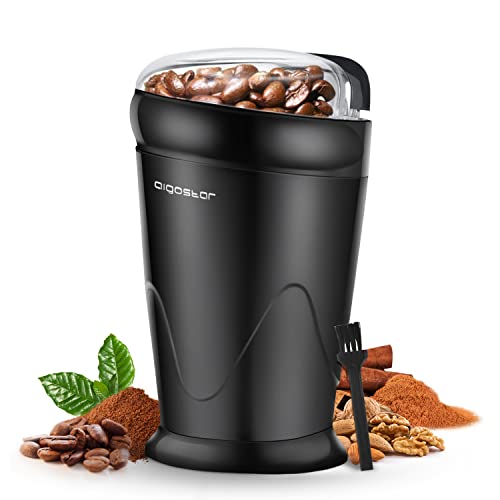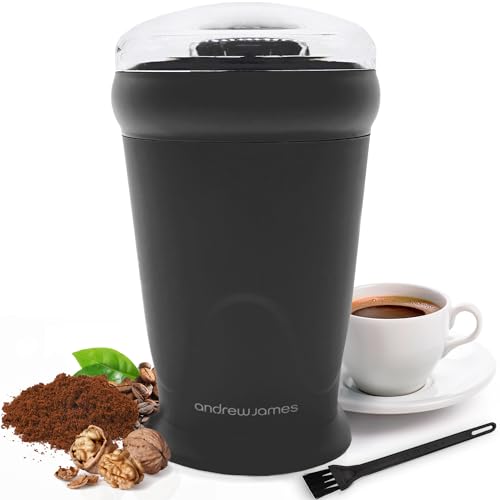Coffee Grinders Types Tools To Ease Your Daily Life Coffee Grinders Ty…
페이지 정보

본문
 Coffee Grinders Types
Coffee Grinders TypesIn the world of coffee burr grinders are highly praised for their ability to create consistent grind sizes. The consistency is key because it guarantees a balanced extraction of flavors and oils.
Burr grinders grind beans by crushing them against two rotating, abrasive surfaces. The distance between the burrs of these grinders can be adjusted to give greater precision than blades. They are also quieter and more affordable.
Conical Burrs
Burr grinders are available in two forms that are conical and flat. The former are typically found on cheaper models while the latter can be seen on premium grinders. Both types of grinders are capable of delivering a fine enough espresso grind however there are some differences that make one type better suited for certain people. These differences mainly have to do with particle size distribution, waste created in each grind session, noise, heat, and price.
In a conical grinder, an inner blade that's attached to the body of the grinder is surrounded by an outer burr set as a collar. The burrs rotate when the grinder is running to change the gap between them. This results in the same grinding effect as the way scissors cut paper. The ridges on the burrs capture the coffee and force them against one another to break them into smaller pieces. They are then ground down further until they become dust. As the process continues, these smaller particles are pushed away from the grinding hole onto the coffee machine and grinder grounds tray below.
Because the ridges of conical burrs are rounded, they generate less friction and therefore less heat than flat burrs do. This helps preserve the integrity of the coffee's natural flavors. It also means that the grinder can be used for longer durations of time without overheating.
Conical burrs are also less difficult to clean than flat burrs. This is important, especially when you brew your coffee several times per day. It is essential to get rid of any stale coffee residue before brewing. Luckily, this shouldn't be much of a problem with modern electronic grinders that have easy cleaning functions.
Aside from being easier to clean, conical burrs are also able to be more effective at producing a finer grind than flat burrs. This can be important for some brew methods, like best budget espresso grinder, that require a precise particle size. Flat burrs usually produce a cup with a fuller flavor, whereas conical burrs provide a more balanced taste.
Flat Burrs
A good burr grinder produces an even grind size than a blade grinder, which is a key ingredient in producing high-quality coffee. This consistency ensures that all coffee particles are exposed to water at approximately the same speed and prevents over-extraction and under-extraction. Burr grinders also produce less tiny fragments, known as fines, than other types of grinders. The type of burr used plays a major role in determining the quality, but other aspects are also important, including the speed and noise of the grinder, and whether it is able to hold any tiny fragments.
While flat and conical grinders differ in the form, they both do a great job of ensuring that the beans are evenly ground. The differences between these two types are more a matter for preference than anything else.
Both kinds of grinders share a similar mechanism. One rings is serrated and moves against another with jagged edges. The beans are ground to a specific size when the two rings spin. The main differences between them are in their shape, material and heat source, as well as their noise level, and price.
Flat burr grinders generate more heat during the grinding process than conical grinders, which could negatively impact the flavor and aroma. They are also louder and more expensive than conical burr grinders, making them more difficult for some consumers.
When it comes to fines, flat burr grinders do better than conical grinders in retaining them. This is due in part to how they are positioned within the grinder and are usually being mounted horizontally instead of vertically. This stops them from being entangled by the teeth of the grinder, and allows gravity to assist with their expulsion.
Some brewers discover that the fact that they have less fines than conical grinds is a significant selling feature, as this can reduce bitterness and astringency of their coffee. This can be particularly helpful when making espresso which is a difficult brewing method that requires precise temperature control and exact grind size.
Steel Burrs
The geometry of a grinder's burr can affect how a coffee bean is cut and distributed, as well as what kind of grind consistency is achieved. These aspects are crucial for making a great cup of coffee.
For flat burrs, this implies that the geometry of the burr's cutting surface could make it easier or more difficult to create a uniform grind size and distribution of coffee beans. For instance, if the grinder has a large gap between the burrs with flat surfaces, it will be able to hold larger coffee beans, and thus create more of a coarse grind while a smaller gap would result in a more fine grind.
The resulting consistency is essential for brewing success because it ensures that all grounds of coffee are exposed water at an equivalent rate, preventing under- or over-extraction of the coffee bean's flavor. A consistent grind is crucial for ensuring that the beans are ground so that they are equally sized and shape.
When grinding coffee, the type and roast degree of the beans will have a major impact on the speed at which burrs wear. The lighter roasts tends to wear out the burrs faster because they are denser, harder beans than darker roasts. They can also block smaller home-grinders with greater ease.
The amount of time a burr has been in use will also impact the speed at which it wears. If a burr is frequent use it should be replaced sooner than if you only use it occasionally. If a grinder is regularly used, a set replacement burrs must be kept on hand in order to minimize downtime due to the necessity of replacing worn-out burrs.
Another thing to consider is whether a grinder uses metal or ceramic burrs. Ceramic burrs are a popular choice as they are tough and durable and reduce the amount of heat generated during grinding and protecting the coffee bean from damage. They are brittle, and are susceptible to cracking or chipping if small coffee grinder stones or sharp objects come in contact with them while grinding.
Ceramic Burrs
Burrs are a crucial element in a variety of grinder models that are designed for home coffee brewing. These rotating rough surfaces, whether made of steel, ceramic or a unique material like red coffee grinder Speed or Titanium, are essential to produce a uniform grind size. This is vital to ensure that coffee is ground evenly so that it can be extracted easily when it's brewed.
The kind of burr, along with its material, can affect the quality and performance of the grinder. This will help you narrow your choices when it comes to choosing the right machine for your home.
Ceramic burrs are more durable than their steel counterparts, allowing them to remain sharp for longer periods of time without having to be sharpened. This could result in lower costs as you'll need to replace your burrs much less often. Ceramic burrs, however aren't as durable as steel, so they're more susceptible to breaking when dropped.
Steel burrs, which are typically made from a hardened alloy that includes chrome to improve their durability and resistance to corrosion they are typically made of a hardened steel alloy. They are typically used in commercial coffee grinder coffee mills and are identified by their gray matte appearance. They are the standard burrs in grinders, and are often recommended for those who grind large quantities of coffee.
When shopping for a grinder that features steel burrs, you should be aware that they could heat during the grinding process. This could alter the flavor profile of the coffee. This is a concern for coffee lovers who would prefer not to have too hot or burnt taste in their cup of joe.
 Another factor to be aware of is that both types of burrs will eventually require replacement. Over time, the material will wear down and dull, and the quality of your grind will decrease. The majority of grinder manufacturers offer replacement burrs that can be changed without difficulty. Some manufacturers suggest changing the burrs at intervals based on how many pounds you grind every week.
Another factor to be aware of is that both types of burrs will eventually require replacement. Over time, the material will wear down and dull, and the quality of your grind will decrease. The majority of grinder manufacturers offer replacement burrs that can be changed without difficulty. Some manufacturers suggest changing the burrs at intervals based on how many pounds you grind every week.- 이전글20 Things You Must Be Educated About Locksmith For Cars 24.09.01
- 다음글20 Tips To Help You Be Better At Ignition Lock Repair 24.09.01
댓글목록
등록된 댓글이 없습니다.